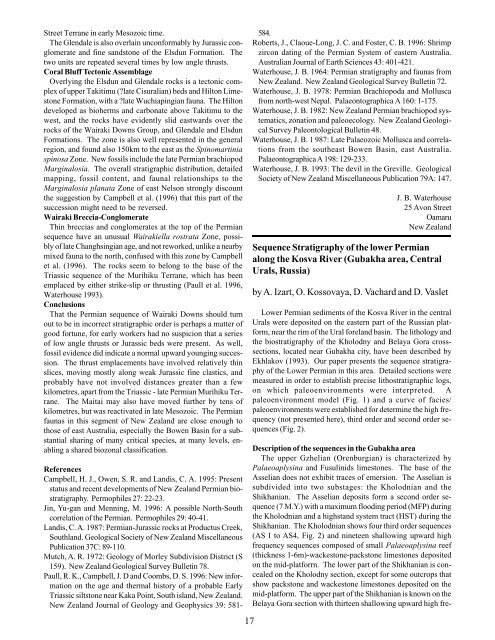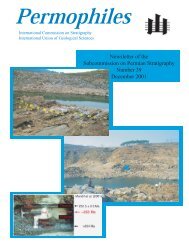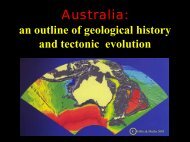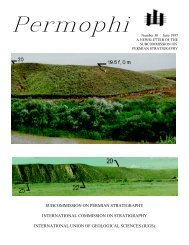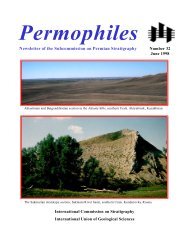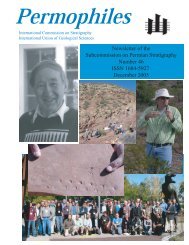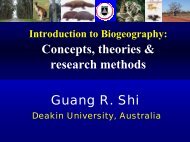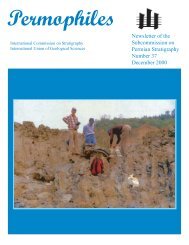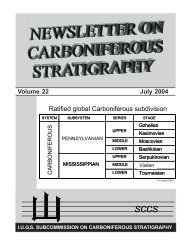Number 31 January 1998 Newsletter of the Subcommission on ...
Number 31 January 1998 Newsletter of the Subcommission on ...
Number 31 January 1998 Newsletter of the Subcommission on ...
You also want an ePaper? Increase the reach of your titles
YUMPU automatically turns print PDFs into web optimized ePapers that Google loves.
Street Terrane in early Mesozoic time.<br />
The Glendale is also overlain unc<strong>on</strong>formably by Jurassic c<strong>on</strong>glomerate<br />
and fine sandst<strong>on</strong>e <str<strong>on</strong>g>of</str<strong>on</strong>g> <str<strong>on</strong>g>the</str<strong>on</strong>g> Elsdun Formati<strong>on</strong>. The<br />
two units are repeated several times by low angle thrusts.<br />
Coral Bluff Tect<strong>on</strong>ic Assemblage<br />
Overlying <str<strong>on</strong>g>the</str<strong>on</strong>g> Elsdun and Glendale rocks is a tect<strong>on</strong>ic complex<br />
<str<strong>on</strong>g>of</str<strong>on</strong>g> upper Takitimu (?late Cisuralian) beds and Hilt<strong>on</strong> Limest<strong>on</strong>e<br />
Formati<strong>on</strong>, with a ?late Wuchiapingian fauna. The Hilt<strong>on</strong><br />
developed as bioherms and carb<strong>on</strong>ate above Takitimu to <str<strong>on</strong>g>the</str<strong>on</strong>g><br />
west, and <str<strong>on</strong>g>the</str<strong>on</strong>g> rocks have evidently slid eastwards over <str<strong>on</strong>g>the</str<strong>on</strong>g><br />
rocks <str<strong>on</strong>g>of</str<strong>on</strong>g> <str<strong>on</strong>g>the</str<strong>on</strong>g> Wairaki Downs Group, and Glendale and Elsdun<br />
Formati<strong>on</strong>s. The z<strong>on</strong>e is also well represented in <str<strong>on</strong>g>the</str<strong>on</strong>g> general<br />
regi<strong>on</strong>, and found also 150km to <str<strong>on</strong>g>the</str<strong>on</strong>g> east as <str<strong>on</strong>g>the</str<strong>on</strong>g> Spinomartinia<br />
spinosa Z<strong>on</strong>e. New fossils include <str<strong>on</strong>g>the</str<strong>on</strong>g> late Permian brachiopod<br />
Marginalosia. The overall stratigraphic distributi<strong>on</strong>, detailed<br />
mapping, fossil c<strong>on</strong>tent, and faunal relati<strong>on</strong>ships to <str<strong>on</strong>g>the</str<strong>on</strong>g><br />
Marginalosia planata Z<strong>on</strong>e <str<strong>on</strong>g>of</str<strong>on</strong>g> east Nels<strong>on</strong> str<strong>on</strong>gly discount<br />
<str<strong>on</strong>g>the</str<strong>on</strong>g> suggesti<strong>on</strong> by Campbell et al. (1996) that this part <str<strong>on</strong>g>of</str<strong>on</strong>g> <str<strong>on</strong>g>the</str<strong>on</strong>g><br />
successi<strong>on</strong> might need to be reversed.<br />
Wairaki Breccia-C<strong>on</strong>glomerate<br />
Thin breccias and c<strong>on</strong>glomerates at <str<strong>on</strong>g>the</str<strong>on</strong>g> top <str<strong>on</strong>g>of</str<strong>on</strong>g> <str<strong>on</strong>g>the</str<strong>on</strong>g> Permian<br />
sequence have an unusual Wairakiella rostrata Z<strong>on</strong>e, possibly<br />
<str<strong>on</strong>g>of</str<strong>on</strong>g> late Changhsingian age, and not reworked, unlike a nearby<br />
mixed fauna to <str<strong>on</strong>g>the</str<strong>on</strong>g> north, c<strong>on</strong>fused with this z<strong>on</strong>e by Campbell<br />
et al. (1996). The rocks seem to bel<strong>on</strong>g to <str<strong>on</strong>g>the</str<strong>on</strong>g> base <str<strong>on</strong>g>of</str<strong>on</strong>g> <str<strong>on</strong>g>the</str<strong>on</strong>g><br />
Triassic sequence <str<strong>on</strong>g>of</str<strong>on</strong>g> <str<strong>on</strong>g>the</str<strong>on</strong>g> Murihiku Terrane, which has been<br />
emplaced by ei<str<strong>on</strong>g>the</str<strong>on</strong>g>r strike-slip or thrusting (Paull et al. 1996,<br />
Waterhouse 1993).<br />
C<strong>on</strong>clusi<strong>on</strong>s<br />
That <str<strong>on</strong>g>the</str<strong>on</strong>g> Permian sequence <str<strong>on</strong>g>of</str<strong>on</strong>g> Wairaki Downs should turn<br />
out to be in incorrect stratigraphic order is perhaps a matter <str<strong>on</strong>g>of</str<strong>on</strong>g><br />
good fortune, for early workers had no suspici<strong>on</strong> that a series<br />
<str<strong>on</strong>g>of</str<strong>on</strong>g> low angle thrusts or Jurassic beds were present. As well,<br />
fossil evidence did indicate a normal upward younging successi<strong>on</strong>.<br />
The thrust emplacements have involved relatively thin<br />
slices, moving mostly al<strong>on</strong>g weak Jurassic fine clastics, and<br />
probably have not involved distances greater than a few<br />
kilometres, apart from <str<strong>on</strong>g>the</str<strong>on</strong>g> Triassic - late Permian Murihiku Terrane.<br />
The Maitai may also have moved fur<str<strong>on</strong>g>the</str<strong>on</strong>g>r by tens <str<strong>on</strong>g>of</str<strong>on</strong>g><br />
kilometres, but was reactivated in late Mesozoic. The Permian<br />
faunas in this segment <str<strong>on</strong>g>of</str<strong>on</strong>g> New Zealand are close enough to<br />
those <str<strong>on</strong>g>of</str<strong>on</strong>g> east Australia, especially <str<strong>on</strong>g>the</str<strong>on</strong>g> Bowen Basin for a substantial<br />
sharing <str<strong>on</strong>g>of</str<strong>on</strong>g> many critical species, at many levels, enabling<br />
a shared bioz<strong>on</strong>al classificati<strong>on</strong>.<br />
References<br />
Campbell, H. J., Owen, S. R. and Landis, C. A. 1995: Present<br />
status and recent developments <str<strong>on</strong>g>of</str<strong>on</strong>g> New Zealand Permian biostratigraphy.<br />
Permophiles 27: 22-23.<br />
Jin, Yu-gan and Menning, M. 1996: A possible North-South<br />
correlati<strong>on</strong> <str<strong>on</strong>g>of</str<strong>on</strong>g> <str<strong>on</strong>g>the</str<strong>on</strong>g> Permian. Permophiles 29: 40-41.<br />
Landis, C. A. 1987: Permian-Jurassic rocks at Productus Creek,<br />
Southland. Geological Society <str<strong>on</strong>g>of</str<strong>on</strong>g> New Zealand Miscellaneous<br />
Publicati<strong>on</strong> 37C: 89-110.<br />
Mutch, A. R. 1972: Geology <str<strong>on</strong>g>of</str<strong>on</strong>g> Morley Subdivisi<strong>on</strong> District (S<br />
159). New Zealand Geological Survey Bulletin 78.<br />
Paull, R. K., Campbell, J. D and Coombs, D. S. 1996: New informati<strong>on</strong><br />
<strong>on</strong> <str<strong>on</strong>g>the</str<strong>on</strong>g> age and <str<strong>on</strong>g>the</str<strong>on</strong>g>rmal history <str<strong>on</strong>g>of</str<strong>on</strong>g> a probable Early<br />
Triassic siltst<strong>on</strong>e near Kaka Point, South island, New Zealand.<br />
New Zealand Journal <str<strong>on</strong>g>of</str<strong>on</strong>g> Geology and Geophysics 39: 581-<br />
17<br />
584.<br />
Roberts, J., Claoue-L<strong>on</strong>g, J. C. and Foster, C. B. 1996: Shrimp<br />
zirc<strong>on</strong> dating <str<strong>on</strong>g>of</str<strong>on</strong>g> <str<strong>on</strong>g>the</str<strong>on</strong>g> Permian System <str<strong>on</strong>g>of</str<strong>on</strong>g> eastern Australia.<br />
Australian Journal <str<strong>on</strong>g>of</str<strong>on</strong>g> Earth Sciences 43: 401-421.<br />
Waterhouse, J. B. 1964: Permian stratigraphy and faunas from<br />
New Zealand. New Zealand Geological Survey Bulletin 72.<br />
Waterhouse, J. B. 1978: Permian Brachiopoda and Mollusca<br />
from north-west Nepal. Palae<strong>on</strong>tographica A 160: 1-175.<br />
Waterhouse, J. B. 1982: New Zealand Permian brachiopod systematics,<br />
z<strong>on</strong>ati<strong>on</strong> and paleoecology. New Zealand Geological<br />
Survey Pale<strong>on</strong>tological Bulletin 48.<br />
Waterhouse, J. B. 1 987: Late Palaeozoic Mollusca and correlati<strong>on</strong>s<br />
from <str<strong>on</strong>g>the</str<strong>on</strong>g> sou<str<strong>on</strong>g>the</str<strong>on</strong>g>ast Bowen Basin, east Australia.<br />
Palae<strong>on</strong>tographica A 198: 129-233.<br />
Waterhouse, J. B. 1993: The devil in <str<strong>on</strong>g>the</str<strong>on</strong>g> Greville. Geological<br />
Society <str<strong>on</strong>g>of</str<strong>on</strong>g> New Zealand Miscellaneous Publicati<strong>on</strong> 79A: 147.<br />
J. B. Waterhouse<br />
25 Av<strong>on</strong> Street<br />
Oamaru<br />
New Zealand<br />
Sequence Stratigraphy <str<strong>on</strong>g>of</str<strong>on</strong>g> <str<strong>on</strong>g>the</str<strong>on</strong>g> lower Permian<br />
al<strong>on</strong>g <str<strong>on</strong>g>the</str<strong>on</strong>g> Kosva River (Gubakha area, Central<br />
Urals, Russia)<br />
by A. Izart, O. Kossovaya, D. Vachard and D. Vaslet<br />
Lower Permian sediments <str<strong>on</strong>g>of</str<strong>on</strong>g> <str<strong>on</strong>g>the</str<strong>on</strong>g> Kosva River in <str<strong>on</strong>g>the</str<strong>on</strong>g> central<br />
Urals were deposited <strong>on</strong> <str<strong>on</strong>g>the</str<strong>on</strong>g> eastern part <str<strong>on</strong>g>of</str<strong>on</strong>g> <str<strong>on</strong>g>the</str<strong>on</strong>g> Russian platform,<br />
near <str<strong>on</strong>g>the</str<strong>on</strong>g> rim <str<strong>on</strong>g>of</str<strong>on</strong>g> <str<strong>on</strong>g>the</str<strong>on</strong>g> Ural foreland basin. The lithology and<br />
<str<strong>on</strong>g>the</str<strong>on</strong>g> biostratigraphy <str<strong>on</strong>g>of</str<strong>on</strong>g> <str<strong>on</strong>g>the</str<strong>on</strong>g> Kholodny and Belaya Gora crosssecti<strong>on</strong>s,<br />
located near Gubakha city, have been described by<br />
Ekhlakov (1993). Our paper presents <str<strong>on</strong>g>the</str<strong>on</strong>g> sequence stratigraphy<br />
<str<strong>on</strong>g>of</str<strong>on</strong>g> <str<strong>on</strong>g>the</str<strong>on</strong>g> Lower Permian in this area. Detailed secti<strong>on</strong>s were<br />
measured in order to establish precise lithostratigraphic logs,<br />
<strong>on</strong> which paleoenvir<strong>on</strong>ments were interpreted. A<br />
paleoenvir<strong>on</strong>ment model (Fig. 1) and a curve <str<strong>on</strong>g>of</str<strong>on</strong>g> facies/<br />
paleoenvir<strong>on</strong>ments were established for determine <str<strong>on</strong>g>the</str<strong>on</strong>g> high frequency<br />
(not presented here), third order and sec<strong>on</strong>d order sequences<br />
(Fig. 2).<br />
Descripti<strong>on</strong> <str<strong>on</strong>g>of</str<strong>on</strong>g> <str<strong>on</strong>g>the</str<strong>on</strong>g> sequences in <str<strong>on</strong>g>the</str<strong>on</strong>g> Gubakha area<br />
The upper Gzhelian (Orenburgian) is characterized by<br />
Palaeoaplysina and Fusulinids limest<strong>on</strong>es. The base <str<strong>on</strong>g>of</str<strong>on</strong>g> <str<strong>on</strong>g>the</str<strong>on</strong>g><br />
Asselian does not exhibit traces <str<strong>on</strong>g>of</str<strong>on</strong>g> emersi<strong>on</strong>. The Asselian is<br />
subdivided into two substages: <str<strong>on</strong>g>the</str<strong>on</strong>g> Kholodnian and <str<strong>on</strong>g>the</str<strong>on</strong>g><br />
Shikhanian. The Asselian deposits form a sec<strong>on</strong>d order sequence<br />
(7 M.Y.) with a maximum flooding period (MFP) during<br />
<str<strong>on</strong>g>the</str<strong>on</strong>g> Kholodnian and a highstand system tract (HST) during <str<strong>on</strong>g>the</str<strong>on</strong>g><br />
Shikhanian. The Kholodnian shows four third order sequences<br />
(AS I to AS4, Fig. 2) and nineteen shallowing upward high<br />
frequency sequences composed <str<strong>on</strong>g>of</str<strong>on</strong>g> small Palaeoaplysina reef<br />
(thickness 1-6m)-wackest<strong>on</strong>e-packst<strong>on</strong>e limest<strong>on</strong>es deposited<br />
<strong>on</strong> <str<strong>on</strong>g>the</str<strong>on</strong>g> mid-platforrn. The lower part <str<strong>on</strong>g>of</str<strong>on</strong>g> <str<strong>on</strong>g>the</str<strong>on</strong>g> Shikhanian is c<strong>on</strong>cealed<br />
<strong>on</strong> <str<strong>on</strong>g>the</str<strong>on</strong>g> Kholodny secti<strong>on</strong>, except for some outcrops that<br />
show packst<strong>on</strong>e and wackest<strong>on</strong>e limest<strong>on</strong>es deposited <strong>on</strong> <str<strong>on</strong>g>the</str<strong>on</strong>g><br />
mid-platform. The upper part <str<strong>on</strong>g>of</str<strong>on</strong>g> <str<strong>on</strong>g>the</str<strong>on</strong>g> Shikhanian is known <strong>on</strong> <str<strong>on</strong>g>the</str<strong>on</strong>g><br />
Belaya Gora secti<strong>on</strong> with thirteen shallowing upward high fre-


